Maxwell Hyett
All images by and courtesy the artist.
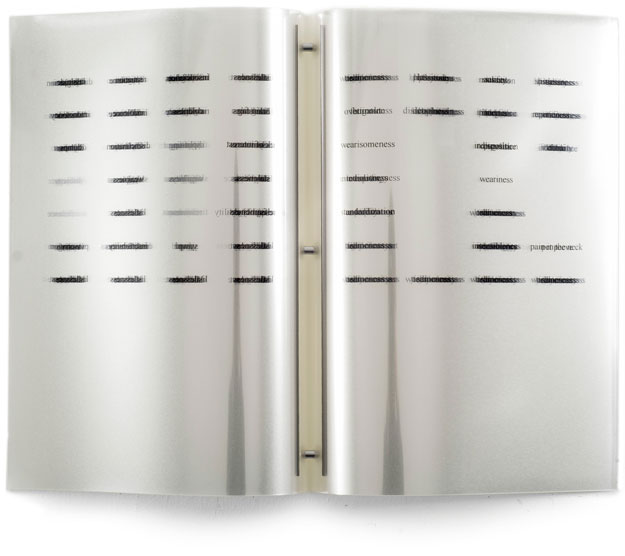
Boredom Studies, open, 2016, Acetate.
– Fredric Jameson, Postmodernism and Consumer Society
INTRODUCTION
Agreement, objectivity, perfect communication: in contemporary society, it seems that these are things of the past, no longer functional – if believable at all. Is it just me or is it exceedingly difficult to believe what is written by the media, our governments, doctors and educators? Half of what is said is jargon specific to a discipline I’m likely to lie to myself about being a part of in some capacity. The other half is left in a limbo of understanding because I can’t decipher the first half, but I’m not fully willing to admit it. I mean, here are the facts laid out in front of me in this article, bill, prescription, or syllabus – of course I know what ‘they’ are saying. Information culture often gives me a creeping suspicion that the more we know the less we understand; a great place for the ambiguities of art.
This experience lead to the development of an intense interest in exploring the root of this feeling of dissociation: semiotics and the making of meaning. Where is meaning kept and how do we find it? Out of my research came work about research, about reading and about trying to understand symbols often forgotten to be just symbols. The more I learned the more I became overwhelmed by a mounting list of books and essays to read, journals to keep up with and ideas to develop. Each development created new tangents sprouting their own trees of research, demanding care and attention into the unforeseeable future. I often felt as though I was drowning in my research even though I was aware of only having scratched the surface of a few topics (don’t you feel the same?). The knowledge I supposedly received was degenerating into just information, meaningless and abstract, unrelated to life and difficult to judge the validity or relevance. I was driven to absorb as much information as I could, but the research began to feel superficial – aloof. What are these things I’m looking at? Words? Why are there so many of them? Couldn’t they be condensed? And the complex ones, couldn’t they come with explanations?

For every one who flees there are many more who chase, 2016, Found book.
METHOD
By layering words, specifically synonyms, directly on top of one another my work presents a visual call to messy linguistic adventure, the words becoming an indistinguishable mass – a void or gap of meaninglessness. Arranged in a stack that recedes backwards into the page the new symbol simultaneously obscures itself and its intentions while (theoretically) broadening its potential meaning; if only the direction of the layers were to change from front-to-back to left-to-right it may be legible. The distance between the sign and the signified is stretched to an extreme, becoming a dysfunctional deconstruction. This process produces seemingly random compositions that remove meaning and destabilize a direct understanding of language as it is traditionally read. I’ve expanded on this idea to make it more legible and diagrammatic in my bookworks (to be discussed later), arranging related words into graphs to better display the battle for meaning. The idea that words are arbitrarily assigned to their meanings is not new, but to experience this arbitrariness simultaneously across a concept bracketed by its synonyms made the experience at once visceral, tangible and surprisingly unsettling.
These symbols do not connote understanding, but rather confusion. Instead of adding more meaning I create voids of meaninglessness, empty and obscuring which stand in stark contrast to the process of layering. Various forms of digging and the physical action of removal are frustrated modes I use in my work that fruitlessly attempt to retrieve the lost understanding. In calmer moments, I layer transparencies to work with a similar sense of regression. Either way, words are placed in material instead of on it in a McLuhanian gesture, drawing attention to the medium (physical) and thereby the message (textual). Neither of which are the actual intention or thought that is trying to be communicated, they are simply the containers. This often produces frustration because we can never truly share a direct connection to our ‘pure’ thought, just mediations between intention and reception. I like to test my naive hypothesis that meaning is stored inside the physical qualities of text (as with the Classical notions of beauty objectively being in the subject) and that reality isn’t as unstable as post-modernism would have us believe, treating the medium as the impossibility of the message – empty without association. If meaning is buried inside of the text that contains it (or maybe more accurately, if the meaning is viewed through the narrow window of text) then the text should be buried or framed by the material that contain
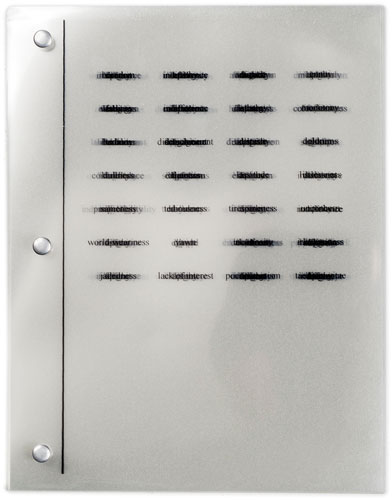
Boredom Studies, 2016, Acetate.
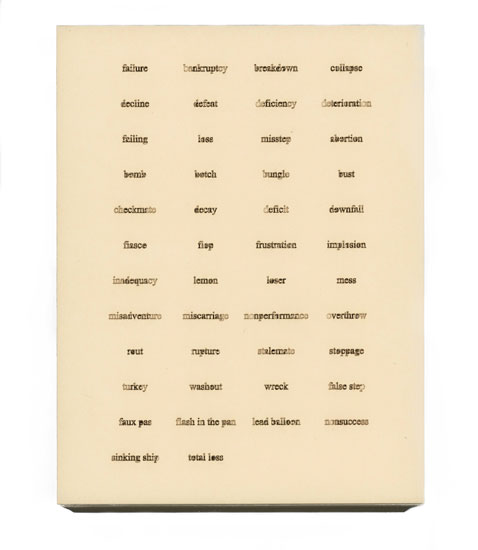
failure, 2016, Paper.
DIAGRAM
The diagram of a concept may be abstract, but it is grounded and shared through the physical. My bookworks, Boredom Studies and Failure, explore both removal and layering in an experimental diagram. A topographical map of a concept: I begin with a word of interest that is then layered on top of its synonyms gradually obscuring it. These same synonyms are then organized across the front page in the same order behind which are their own respective synonyms. Each word has a synonymic group of different length causing some to run out earlier than others leaving behind a blank space on the successive pages as words with more synonyms continue on. The layering of words on top of one another along with their first and secondary-synonyms comingles with the spectator’s reflection (both contemplatively and at times literally) – a confluence of self and other, intention and reception. Brought together in this way a family of words are displayed under one conceptual canopy for you to read and explore as you will. Inevitably there are some terms that are obviously related such as ‘boredom’ and ‘apathy’, but there are more surprising observations that emerge: only 13 of 49 synonyms of ‘belief’ are reflexively synonymous with ‘belief’, ‘failure’ is synonymous with two foods; ‘lemon’ and ‘turkey’, and ‘fortune’ has 14 synonyms to ‘misfortune’s’ 46. What are the implications of these observations? If this schematic was woven into our use of language would it have an affect or is it already there lying low in our unconscious somewhere? It can be difficult at times to know what parts of language are arbitrary and what parts are deliberate, perhaps it is all just various shades of grey.
By manipulating the diagram and temporal experience of a set of symbols the content or meaning is lost. What remains is the context, the shadow of text and cultural symbol. My work plays on recognition of the subject by creating confusing composite images that radiate a familiarity that can be difficult to place. Maintaining this odd semblance of familiarity, I investigate plurality and simultaneity, excavating around them to try and expose the possibility, absurdity, and arbitrariness that seem to come as a package deal. However, the main issue at hand in this layering process is the difference between information and knowledge. By utilizing symbols of cultural and communicative significance there is a play upon the symbol that is worth more than its aesthetics. By layering symbols, meaning is taken apart, dismantled and subjected to interpretations that are far more fluid and personal than before. In 1957, Marcel Duchamp gave a lecture suggesting that the creative act is spread equally between artist and spectator, ‘all in all, the creative act is not performed by the artist alone; the spectator brings the work in contact with the external world’.[1] This is the difference between intention and reception in the creation of meaning.

A tight grip on the, this, that moment, 2016, paper and paperclip.
INTERPRETATION
In On Deconstruction: Theory and Criticism after Structuralism, Jonathan Culler, 1982 describes deconstruction as something that ‘reveals the impossibility of any science of literature or science of discourse and returns critical inquiry to the task of interpretation’.[2] Interpretation as critical inquiry was the source of aforementioned frustration and meaninglessness I felt towards my research. The works’ inspiration – although I hadn’t acknowledged it yet – was the recognition of each piece of research as an interpretation, not truth. This post-structuralist view is built upon the idea that meaning is associative and exists in a subjective context, not in the object/subject. Because of this, I believe we find forms of meaning and understanding through memory. The laborious process of working away on a text can be expressed through the approach of ancient thinkers. In antiquity, knowledge was attained through rote memorization of texts and contemplation. Memorization is often played down today, replaced by Google searches and CTRL-F functions. This is a symptom of text not as memory but as a reminder, as stated by Plato’s characters in Phaedrus when offered the gift of writing: ‘‘If men learn [writing], it will implant forgetfulness in their souls,’ he told the god. ‘They will cease to exercise their memory and become forgetful; they will rely on that which is written, calling things to remembrance no longer from within themselves, but by means of external marks. What you have discovered is a recipe not for memory but for reminding’. The absorption of knowledge is something that takes time, effort and repetition; ‘one didn’t just memorize texts; one ruminated on them – chewed them up and regurgitated them like cud – and, in the process, became intimate with them in a way that made them one’s own’.[3] This process of memorization is characterized by an act of interpretation to make it ‘one’s own’. Each word, sentence and idea is transformed into departures from the original idea, but not separations from it. I highlight, perhaps demand… let’s say ‘politely ask with force’… that we recognize and honour this process; if we don’t make meaning on our own then it is done for us by media. This stems from post-structuralist ideas of reality being founded on interpretation and subjectivity. As we witness in the removal of meaning the only thing left in the wake of the layered symbol is interpretation: the void spaces (either literally or through symbolic uncertainty) explicitly ask viewers to ‘read into’ the image, to fill the void with their interpretations.
One might hope to see more of a material connection between linguistics and abstract concepts (I know that I do), but when looking at text we are invited to experience and learn about things beyond our physical and psychological confinements. In this sense, we see through text, past the physical qualities of letters and their diagrams, to the meaning they represent even though unrelated. The act of reading is an exploration of new ideas, connections, stories and characters. It is a creative act that works the imagination by using the repeating symbols of text as reminders of sounds, concepts, images and more. We stitch these together into a rich and vibrant internal scene that is both incredibly personal as well as shared. Looking through text only seems possible when it is a reminder of previous ideas and associations. When confronted with unfamiliar or ambiguous terms the functioning of the symbol becomes a struggle that may vary well be futile. The diagram fails, so we dig into these terms looking for definitions in dictionaries, synonyms in thesauri and related concepts in other writings or places to rebuild and adapt our map. As we dig our own personal understandings of words are actively projected into the terms as we build networks of meaning through association and similarity – we must first move through similitude to get to representation. Unknown terms in this way remind us of what we already know.
Using text, my work contrasts a lack of visual similarity in words against the ideas that bind them together. The words simply act as reminders that emphasize the lack of objective and foundational truths. Although my work acts to highlight a lack of inherent meaning in meaning making processes, this knowledge encourages the creation of subjective meanings that we share and enjoy in their variety (or be crushed by their alienating affects). The artist may have pointed intentions with their work but when it comes down to it ‘he will have to wait for the verdict of the spectator’.[4]
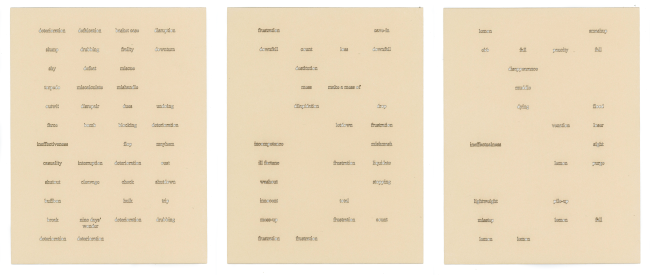
failure p.8, p.23, p.26, 2016, Paper.
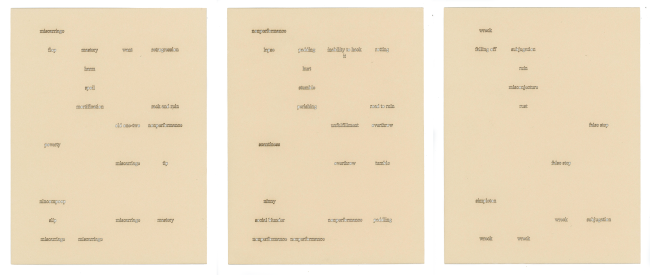
failure p.30, p.31, p.39, 2016, Paper.
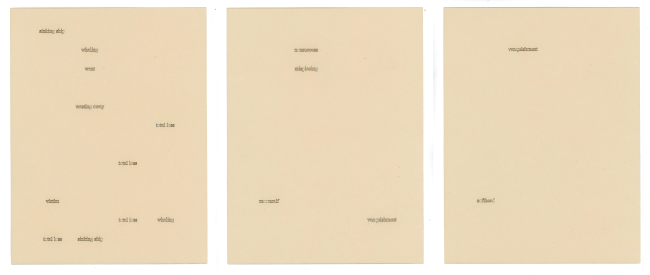
failure p.45, p.51, p.52, 2016, Paper.
[1] Duchamp, Marcel. ‘The Creative Act: Marcel Duchamp’s 1957 Classic, Read by the Artist Himself.’ Brain Pickings RSS. Web. 22 Mar. 2015. <http://www.brainpickings.org/2012/08/23/the-creative-act-marcel-duchamp-1957/>.
[2] Culler, Jonathan D. On Deconstruction: Theory and Criticism after Structuralism (Ithaca, N.Y.: Cornell UP, 1982), 220.
[3] Foer, Joshua. Moonwalking with Einstein: The Art and Science of Remembering Everything (New York: Penguin, 2011), 110.
Maxwell Hyett is a Toronto-based interdisciplinary artist and writer. His work explores issues of meaning, simultaneity, and the relationship between language and reality. These issues emerge primarily as a concern with information and its reception: how is information made; where do we keep it; how do we retrieve it; and how does it translate through these processes? Maxwell develops these ideas by creating collisions between synonyms and related terms to question the unavoidable connections we make between symbols and learned meaning.
Maxwell holds a BFA from OCAD University in Toronto and is currently represented by Galerie Youn in Montreal. He has shown in both Canada and Italy at events and venues such as: Art Toronto, The Gladstone Hotel, Mercedes-Benz Financial Services, and The British Institute in Florence. Maxwell was the recipient of the Josephine Polera Entrance Scholarship and the Av Isaacs Award.
Maxwell has been heavily influence by, and draws inspiration from, medieval manuscripts, mythology, and structuralist/post-structuralist theory. These influences mark an aesthetic and conceptual focus on the context through which we access information, knowledge and wisdom.